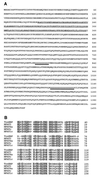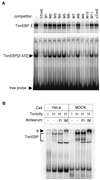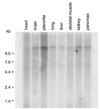Tonicity-responsive enhancer binding protein, a rel-like protein that stimulates transcription in response to hypertonicity
- PMID: 10051678
- PMCID: PMC26820
- DOI: 10.1073/pnas.96.5.2538
Tonicity-responsive enhancer binding protein, a rel-like protein that stimulates transcription in response to hypertonicity
Abstract
Hypertonicity (most often present as high salinity) is stressful to the cells of virtually all organisms. Cells survive in a hypertonic environment by increasing the transcription of genes whose products catalyze cellular accumulation of compatible osmolytes. In mammals, the kidney medulla is normally hypertonic because of the urinary concentrating mechanism. Cellular accumulation of compatible osmolytes in the renal medulla is catalyzed by the sodium/myo-inositol cotransporter (SMIT), the sodium/chloride/betaine cotransporter, and aldose reductase (synthesis of sorbitol). The importance of compatible osmolytes is underscored by the necrotic injury of the renal medulla and subsequent renal failure that results from the inhibition of SMIT in vivo by administration of a specific inhibitor. Tonicity-responsive enhancers (TonE) play a key role in hypertonicity-induced transcriptional stimulation of SMIT, sodium/chloride/betaine cotransporter, and aldose reductase. We report the cDNA cloning of human TonE binding protein (TonEBP), a transcription factor that stimulates transcription through its binding to TonE sequences via a Rel-like DNA binding domain. Western blot and immunohistochemical analyses of cells cultured in hypertonic medium reveal that exposure to hypertonicity elicits slow activation of TonEBP, which is the result of an increase in TonEBP amount and translocation to the nucleus.
Figures





Comment in
-
What sets the TonE during osmotic stress?Proc Natl Acad Sci U S A. 1999 Mar 2;96(5):1814-6. doi: 10.1073/pnas.96.5.1814. Proc Natl Acad Sci U S A. 1999. PMID: 10051549 Free PMC article. Review. No abstract available.
References
-
- Yancey P H, Clark M E, Hand S C, Bowlus R D, Somero G N. Science. 1982;217:1214–1222. - PubMed
-
- Lucht J M, Bremer E. FEMS Microbiol Rev. 1994;14:3–20. - PubMed
-
- Ishitani M, Nakamura T, Han S Y, Takabe T. Plant Mol Physiol. 1995;27:307–315. - PubMed
-
- Yamauchi A, Uchida S, Preston A S, Kwon H M, Handler J S. Am J Physiol. 1993;264:F20–F23. - PubMed
Publication types
MeSH terms
Substances
Associated data
- Actions
Grants and funding
LinkOut - more resources
Full Text Sources
Other Literature Sources
Molecular Biology Databases

